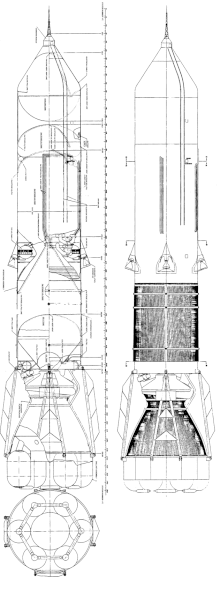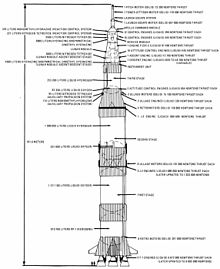Sea dragon (rocket)



The sea dragon is a two-stage rocket of the reuse type investigated in 1962. The number that Robert Truax which worked in aerojet company led this plan, and he devised was one of the designs that there was and launched it from surfacing structure financial standing on the ocean. NASA and several people of the Todd Pacific shipyard showed interest, but burnt down at the mid-1960s without being adopted for a next plan of NASA. 150m in total length, the sea dragon of 23m in diameter were going to become the maximum rocket in history.
The basic concept by Truax was a concept called "big dam booster" of the place that said now by developing a large-scale rocket in a low price. Because rocket in itself is launched from the sea to lower an operational expense, there are few support systems and finishes it. I use it as "whist" to launch a rocket perpendicularly by accompanying a large ballast tank system in the bottom of the first step ラバール nozzle. Access becomes easy by installing it on the second step one that the freight just becomes in the draft line. Truax has already performed the experiment of the basic system with Sea Bee[1][2] and sea hose rocket [3] [4]. He took in the materials which were not expensive such as iron plates of 8mm to reduce an expense of rocket in itself. The rocket was constructed at the shipyard of the shore and was going to be towed to the launching sea area.
The first step was the single engine which assumed RP-1 and liquid oxygen of thrust 80 million pounds-force (360 MN) a propellent. The fuel came to be supplied in 圧送式 cycle by the nitrogen gas supplied from the outside, and 32 atm, liquid oxygen were 17 atm, and, in RP-1, the total pressure at the time of the engine getting up was going to be pressurized each by 20 atm (~300 psi). Pressure falls out 81 seconds later after launching it, and combustion stops. High 25 miles, distance 20 miles40 km x 33km), the speed arrive at 4,000mph (1.8km/s) at that point. I separate the first step in the normal mission and land on the water of the sea area of 180 miles (290km) at high speed. I was going to collect it by the plan.
The second step comprised a supersized single engine equally, too and was going to burn in liquid hydrogen and liquid oxygen in this case thrust 6000,000kgf. Similarly, it was 圧送式, but in this case it supplies a propellent by low pressure of 7 atm for the drive of the system in succession and I am going to burn for 260 seconds and reach an altitude of 230km, distance 940km at that point. The nozzle of the engine became the structure to extend to improve performance, and the expansion ratio came to be changed at 27:1 from 7:1 as I rose. The overall height of the rocket was shortened a little in the first step tip by putting the second step engine nozzle.
Because maintenance and freight and a ballast tank are coupled, the typical launching procedure begins. I load it with RP-1 and nitrogen equally at this point in time. The rocket is towed to the launching sea area and injects liquid oxygen and liquid hydrogen supplied locally there by electrolysis. ; Truax suggests that I use a nuclear-powered carrier to supply electricity in this stage. A stopper is attached that water is met by a ballast tank and protects the first step engine nozzle, and the rocket stands perpendicularly. I check it just before that, and the rocket is launched without a problem afterwards.
The rocket has ability to cast 550 tons into the low orbit. The expense of the payload is more largely than a current expense $ 600 from $ 59 per cheap kg. TRW estimated inspection and the expense of an evaluation and the design with the review of the plan and surprised NASA. However, the future plan was reduced by the pressure of the budget cut and invited the end to the work of the super heavy goods launcher for Mars existence person flights.
A footnote and source
- ^ Sea Bee
- ^ Sea Bee was a plan to prove a concept principle of the marine discharge. I remodeled the residual aeroB rocket and was lighted underwater. The rocket operated in a restricted state normally. It was said that the cost when I repeated a combustion examination later was approximately 7% of new articles.
- ^ Sea Horse
- The ^ sea hose rocket demonstrated the marine discharge with complicated guidance controls on a bigger scale. An examination of コーポラルミサイル to supply a propellent of the nitric acid / aniline to by pressurization of 9,000 kgf at a lighter of San Francisco Bay was conducted. The first examination was fired in surface of the water lower number m and burnt in succession until I was sunk afterwards and reached the considerable depth. Combustion in the water did not have a problem, and the noise damped.
Outside link
- FAR
- Search "Sea Dragon Concept" at the NASA Technical Report Server to read the unclassified design study:
- Sea Dragon Concept Volume 1 (Summary), LRP 297 (NASA-CR-52817), 1963-01-28.
- Sea Dragon Concept Volume 3 (Preliminary program plan), LRP 297 (NASA-CR-51034), 1963-02-12.
This article is taken from the Japanese Wikipedia Sea dragon (rocket)
This article is distributed by cc-by-sa or GFDL license in accordance with the provisions of Wikipedia.
In addition, Tranpedia is simply not responsible for any show is only by translating the writings of foreign licenses that are compatible with CC-BY-SA license information.
0 개의 댓글:
댓글 쓰기